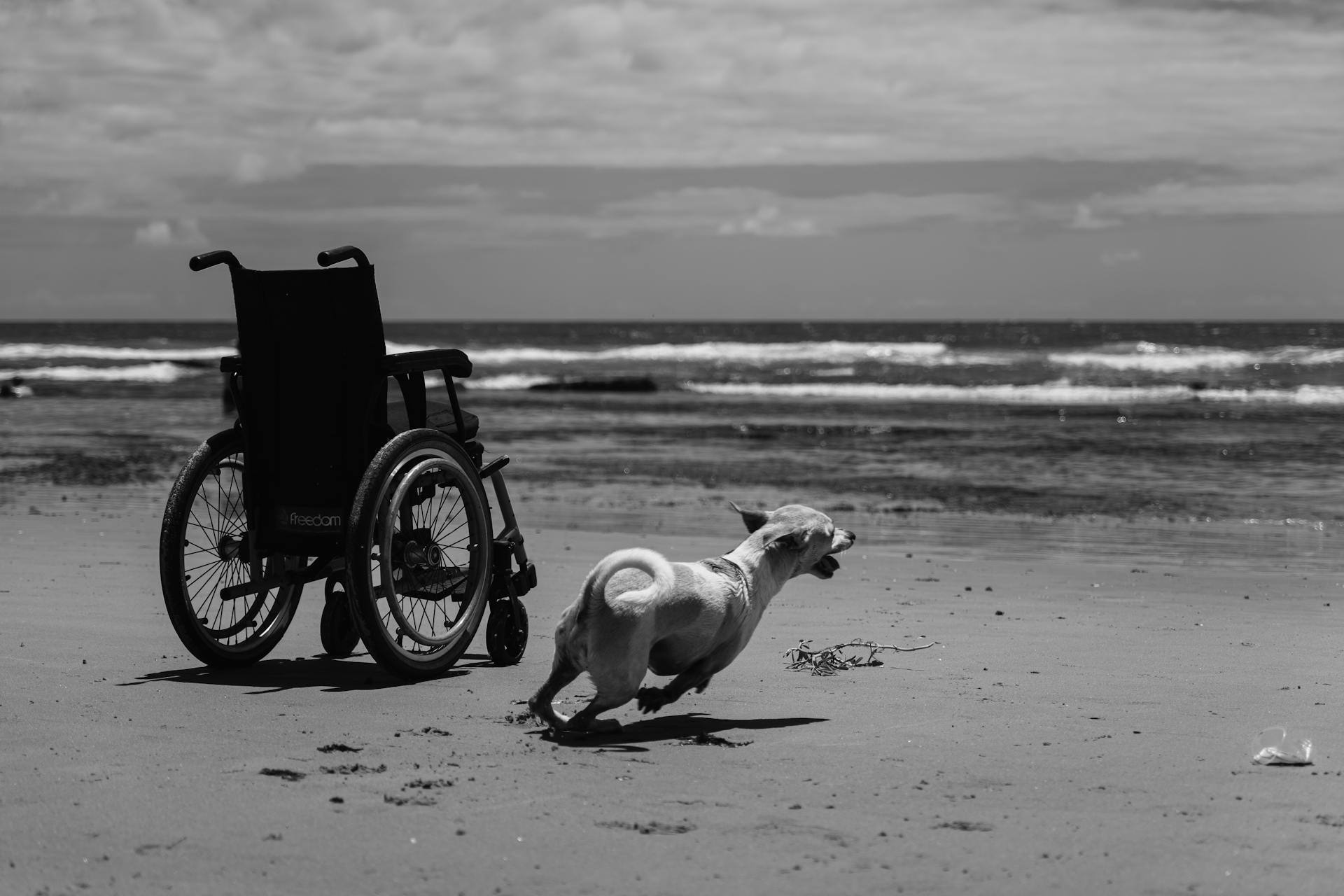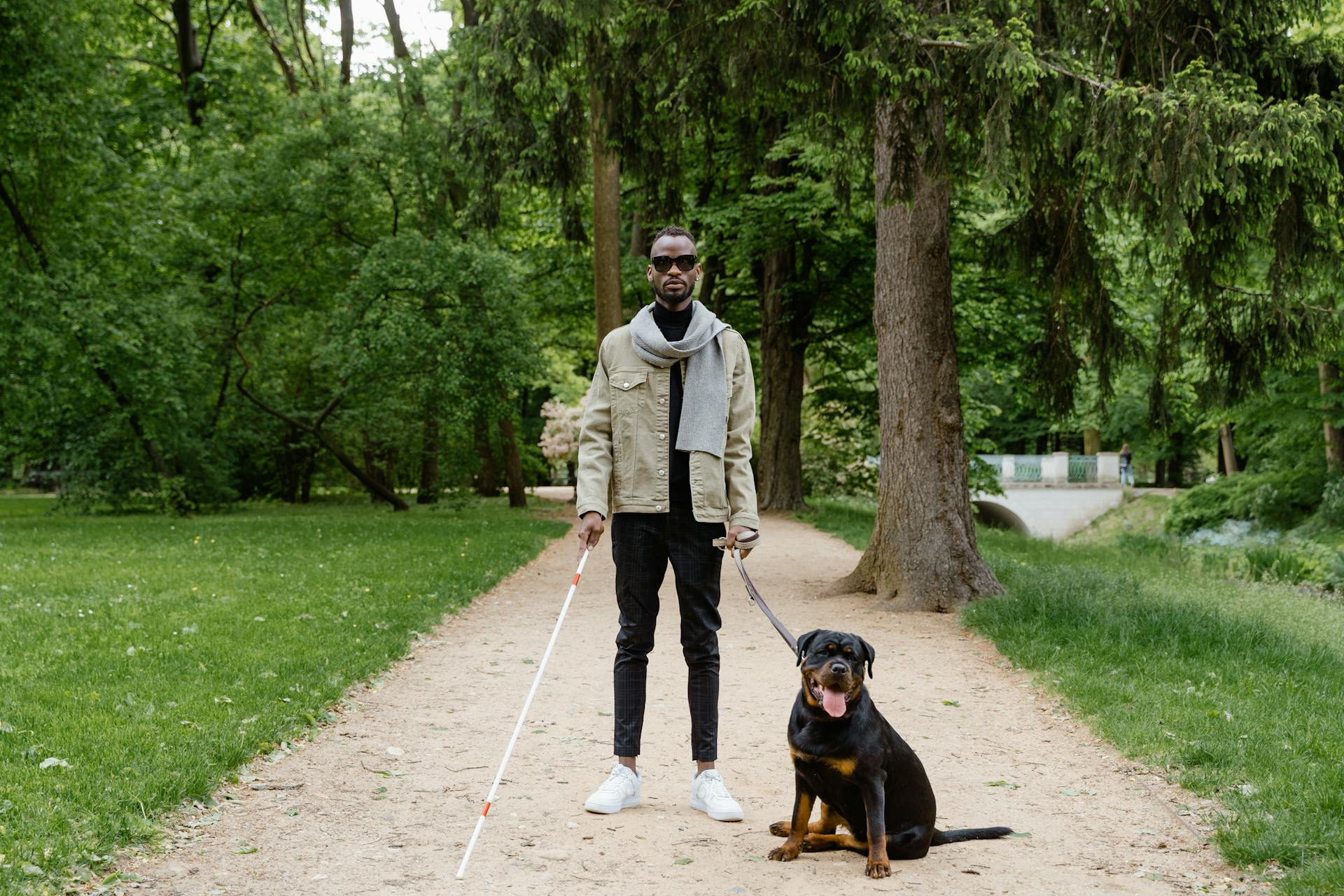
Degenerative myelopathy is a progressive neurological disease that affects dogs, causing a decline in their quality of life.
It typically starts with a loss of coordination and balance, leading to stumbling and falling.
As the disease progresses, dogs may experience weakness, paralysis, and loss of bladder and bowel control.
Degenerative myelopathy can be a devastating diagnosis for dog owners, who often feel helpless as they watch their beloved pets decline.
It's a relatively common condition, affecting many breeds of dogs, including German Shepherds, Labrador Retrievers, and Australian Shepherds.
Symptoms can vary depending on the breed and individual dog, but most dogs will eventually lose the ability to walk and may become paralyzed.
Here's an interesting read: Autoimmune Disease in German Shepherds
Diagnosis and Testing
Degenerative myelopathy can be a challenging disease to diagnose, but with the right tests and evaluations, a veterinarian can make an educated guess. A definitive diagnosis can only be established with a microscopic evaluation of tissue, known as histopathology.
The first step in diagnosing DM is to rule out other spinal cord diseases based on exam findings and imaging. This may involve a physical exam, blood tests, spinal X-rays, and imaging tests like a CT scan or MRI.
A genetic test is available to check for the presence of the SOD 1 mutation, which can determine if a pet is normal, a carrier, or has two copies of the mutated gene. This test can help identify at-risk dogs and those used in breeding programs.
The genetic test provides one of three results: A/A (at risk/affected), A/N (at risk/affected, normal), and N/N (normal). It's essential to remember that even one abnormal copy poses a risk for disease.
Here are the possible results of the genetic test:
MRI is also a helpful tool in diagnosing DM, as it can rule out causes of similar signs such as IVDD and spinal cancers. Additionally, newer MRI studies are showing promise in helping diagnose DM.
Understanding the Condition
Degenerative myelopathy is a serious condition that affects many breeds of dogs, including German Shepherds, Pembroke Welsh Corgis, and Boxers.
The condition is caused by a genetic mutation in the SOD-1 gene, which is responsible for removing free radicals from the body. This mutation leads to the buildup of free radicals, causing damage to the spinal cord.
Dogs with two copies of the mutated gene are at increased risk for developing DM, but it's not a guarantee. In fact, some dogs with two mutated genes may not develop symptoms at all.
If your dog is a carrier of the disease, meaning they have one normal and one abnormal copy of the gene, they have a low risk of developing DM themselves, but a 50% chance of passing the gene to their puppies.
DM is an autosomal recessive genetic disease, which means that a dog must inherit two copies of the mutated gene to express the disease. This is why some dogs may be carriers without showing symptoms.
Degenerative myelopathy affects the white matter of the spinal cord, causing it to break down and leading to a loss of coordination and eventually, the inability to walk.
Treatment and Management
Degenerative myelopathy is an irreversible, progressive disease that cannot be cured. There is currently no treatment to stop the disease, but various therapies can help manage its progression and improve a dog's quality of life.
Physical therapy, such as swimming and walking, can help keep muscle mass in the back legs and prolong a dog's ability to move. Dogs that receive intensive physiotherapy have a significantly longer survival time compared to those that receive moderate or no physiotherapy.
Combination therapies with an exercise regimen have been advocated for treatment of DM. Results from a study of 22 DM-affected dogs suggested that those receiving intensive physiotherapy remained ambulatory longer than those that did not.
Physical therapy can be performed by a Board-Certified Veterinary Neurologist, a boarded specialist in physical rehabilitation and sports medicine, or a general veterinary practitioner. It can include active exercises, passive exercises, massage, hydrotherapy, and paw protection.
Dogs that undergo intensive therapy can live more than three times as long as those that receive no physical rehabilitation (55 days vs 255 days). This highlights the importance of early intervention and regular exercise for dogs with DM.
While there is no cure for DM, supportive care can help manage the disease. This includes wound care, hygiene, and managing bowel and bladder control.
A canine wheelchair can be a valuable tool in maintaining mobility for dogs with DM. Many dogs are happy to use a cart to enjoy their lives, and some may need a little time to adjust.
Intriguing read: Skin Relief for Dogs with Allergies
Here are some ways to care for a dog with DM who is unable to walk:
- Use puppy pads or absorbent pads to make clean-up easier
- Turn the dog every couple of hours to prevent bed sores
- Use memory foam bedding and comforters for padding
- Place padding under the head and between the limbs for comfort
Prognosis and Outcome
Degenerative myelopathy (DM) is a devastating disease that affects dogs, and unfortunately, the prognosis is generally poor. Treatment options are limited, and even with aggressive therapy, the life expectancy is only around 14 months.
The disease progresses rapidly without treatment, with a survival time of around 3 months. However, this option arguably comes with less suffering for the dog.
Some dogs have been able to stay mobile for longer periods with physical therapy, but degenerative myelopathy will eventually worsen with time. Eventually, they will become paralyzed in all limbs.
Caring for a large dog with DM can be challenging, and most owners choose euthanasia once the dog is unable to walk or move, which often happens around 1 year after symptoms start.
The condition typically progresses over 3 months to 3 years, with patients becoming weaker in their pelvic limbs and eventually losing the ability to move. Incontinence may develop, requiring manual bladder expression.
On a similar theme: Degenerative Myelopathy Dogs Treatment
If humane euthanasia is not elected, the brainstem and respiratory centers may become involved, leading to difficulty breathing and death. It's essential to keep track of your dog's good and bad days to decide how they're coping with the disease.
A quality of life scale, such as the HHHHHMM Scale by Dr. Alice Villalobos, can provide guidelines to help you make informed decisions about your dog's care. This scale can be answered monthly and compared to establish trends over time.
Veterinarians Diagnose
Veterinarians diagnose degenerative myelopathy by excluding other spinal cord diseases based on exam findings and imaging. They'll evaluate your dog for spinal and joint pain and perform a neurologic evaluation.
A physical exam is crucial in identifying the clinical signs of DM. Your vet will develop a list of likely causes for your dog's symptoms based on the physical exam findings.
Radiographs (x-rays) may be recommended to evaluate the bones of the spine and hips, but they can't show the spinal cord itself. Your vet may look for evidence of arthritis, misalignment of the spine, or other conditions.
Advanced imaging like a myelogram, computed tomography (CT), or magnetic resonance imaging (MRI) can help evaluate the spinal cord and rule out compression or other issues.
A definitive diagnosis can only be established with a microscopic evaluation of tissue, but veterinarians have other tests that can help rule out other conditions and provide evidence for a diagnosis of DM.
MRI is very helpful in ruling out causes of similar signs like IVDD and spinal cancers. Genetic testing and CSF results may also help clarify the clinical picture.
Here are some common tests used to diagnose DM:
- Blood tests
- Spinal X-ray
- Spinal fluid testing
- Computed tomography scan (CT) scan
- Magnetic resonance imaging (MRI)
- DNA testing
- Myelogram
Keep in mind that genetic testing may not rule out DM if it only tests for the most common SOD-1 mutation.
Frequently Asked Questions
What are the 5 stages of degenerative myelopathy?
Degenerative myelopathy progresses through five stages, from early signs of neurological deficits to complete paralysis. These stages include early stage, early to mid-stage, mid-stage, late stage, and final stage.
What are the first symptoms of degenerative myelopathy in dogs?
Early signs of degenerative myelopathy in dogs include poor coordination, loss of balance, and weakness in the hind legs, often accompanied by swaying or criss-crossing of legs while standing
Can myelopathy come on suddenly?
Yes, acute myelopathy can develop quickly due to various causes such as spinal injuries or infections. Sudden onset is often associated with severe or traumatic events.
At what point do you euthanize a dog with degenerative myelopathy?
Euthanasia is typically considered 6-12 months after diagnosis, when a dog's quality of life is significantly impacted by complete hind limb paralysis. This decision is made to prevent suffering and ensure a peaceful end
Do dogs with DM feel pain?
No, dogs with Canine Degenerative Myelopathy (DM) typically do not experience pain. However, DM is a progressive condition that affects the nervous system, leading to paralysis and other symptoms.
Sources
- https://www.dvm360.com/view/degenerative-myelopathy-diagnosis-and-treatment-proceedings
- https://en.wikipedia.org/wiki/Canine_degenerative_myelopathy
- https://www.webmd.com/pets/dogs/what-to-know-about-degenerative-myelopathy-in-dogs
- https://www.petmd.com/dog/conditions/musculoskeletal/degenerative-myelopathy-dogs
- https://www.vetspecialists.com/vet-blog-landing/animal-health-articles/2023/03/07/Value-of-a-biopsy-report
Featured Images: pexels.com


